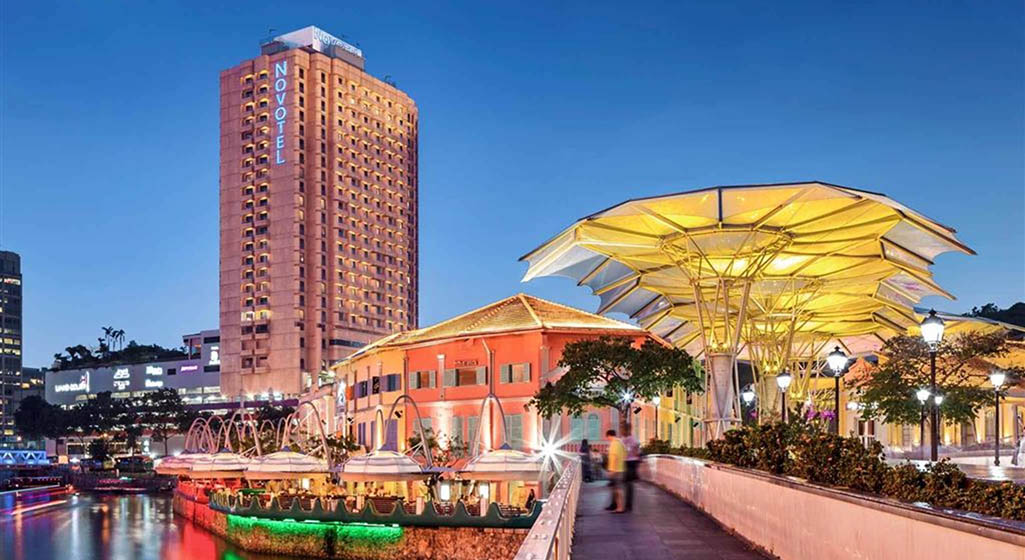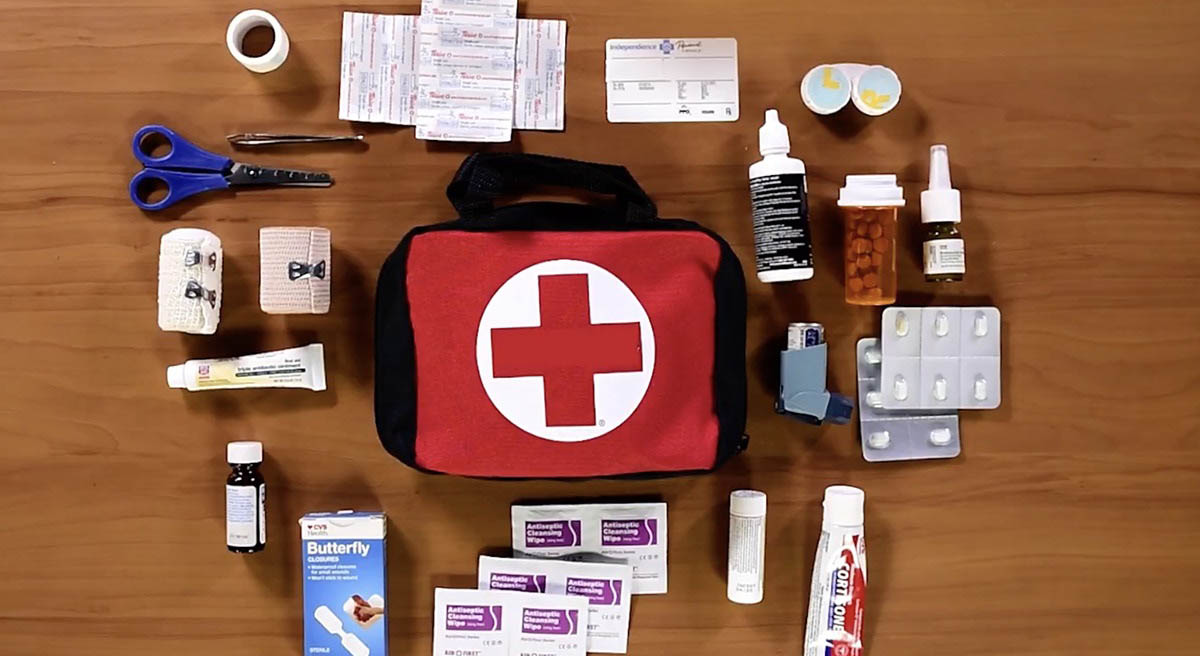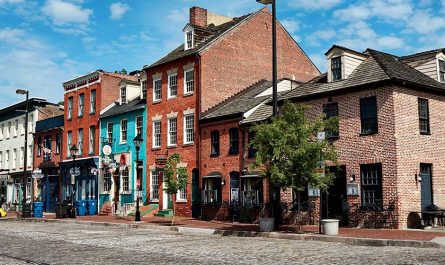1. Why is Gardens by the Bay a Must-See in Singapore?
Created in 2012, the garden cost a staggering 1 billion dollars. This substantial investment by the Singapore government has helped transform the city into a garden. The attraction quickly became Singapore’s most popular site, and you’ll soon understand why when you arrive at the 100-hectare site. The gardens are breathtaking and unique.
Strolling through Gardens by the Bay is free, but we recommend not missing out on the paid attractions, especially the two conservatories: Cloud Forest and Flower Dome. The elevated walkway, 22 meters high, which allows you to wander among the Supertrees, is also a must-see.
High-Tech Botanical Gardens!
Gardens by the Bay is divided into three sections:
- Bay South Garden: Covering 54 hectares, this area attracts the most visitors because it is home to the iconic Supertrees and the two domes.
- Bay East Garden: Another green lung of Singapore, offering superb views of the city’s skyline.
- Bay Central Garden: Links the previous two areas. It is a 3 km waterfront promenade perfect for walking and running. It also offers stunning views of Singapore and its skyline.
2. Must-See Attractions in Gardens by the Bay
2.1. Visit Cloud Forest and Flower Dome
Access to Cloud Forest and Flower Dome costs SGD 28 for both domes. Open from 9 AM to 9 PM, these two glass-covered spaces are not to be missed when visiting Singapore.
Entering Cloud Forest reveals a mysterious world shrouded in mist over 0.8 hectares. Your visit starts in front of a massive waterfall. It’s quite cool inside the dome, offering a noticeable contrast to the outside temperature.
But don’t worry, you’ll quickly get used to it. The visit begins at the foot of a mountain surrounded by tropical vegetation and flowers, then you take an elevator to the top. The rest of the visit alternates between walking inside the mountain and along walkways that offer varying views of Cloud Forest, Singapore, and the iconic Marina Bay Sands Hotel, visible through the glass dome.
After descending the mountain, you end your visit in a lovely hidden garden where orchids and other tropical plants bloom.
Flower Dome, the larger of the two at 1.2 hectares, is equally spectacular. It houses an abundance of plants from Mediterranean and semi-arid regions.
Wander among baobabs and other oddly shaped cacti. Don’t worry, flowers are also prominent, with over 200 species. It’s a head-turning experience as you journey through Australia, California, and South Africa!
2.2. Visit the Supertree Grove at Gardens by the Bay
This is another unmissable area of Gardens by the Bay. It’s the heart of the park, where you must visit under the shade of giant trees called Supertrees that look like they came straight out of a science fiction movie like Avatar. It’s an impressive sight both day and night, and you’ll quickly understand why.
Access to this area is free, as is the nightly show. However, access to the panoramic viewpoint from the observatory and the walkway are paid visits. We tested both.
Access to the Supertree Observatory costs SGD 10 per person and is available daily from 9 AM to 9 PM. You reach it via an elevator located in the trunk of the Supertree. At 50 meters high, you’ll discover a 360-degree panoramic view of the gardens and Marina Bay Sands. It’s especially nice at sunset, and you can enjoy a drink there.
The other major attraction in this area is the OCBC Skyway, an elevated walkway 22 meters high that allows you to wander among the Supertrees, providing a little thrill with each step. The price to access the attraction is SGD 8 per person. It’s open daily from 9 AM to 9 PM but closes if the weather turns bad.
While waiting for the nightly show at the Supertrees, don’t hesitate to visit Floral Fantasy for SGD 12. Open daily from 9 AM to 9 PM, this attraction immerses you in a floral world where artistic talent and technology unite for a unique and fantastic experience. We loved walking under flower bouquets that seemed to float in the sky and the 4D cinema session that offered a different perspective of Gardens by the Bay for 10 minutes.
The Sound and Light Show “Garden Rhapsody”
The “Garden Rhapsody” sound and light show seems like something straight out of a dream. This magical show takes place every day at 7:45 PM and 8:45 PM and lasts 10 minutes. The second show tends to be less crowded, so it’s preferable if you want a bit more peace. It’s a minor detail since the park is quite large, but to get the best experience, we recommend sitting under one of the Supertrees around the observatory. The various light effects are expertly choreographed to music (opera) and delight both young and old! It’s normal if you shed a tear during the grand finale. There are so many beautiful emotions intertwined.
3. Visiting Singapore and the Marina Bay Sands Hotel
Marina Bay Sands is the most iconic hotel in Singapore. You probably have the image of this unique hotel with its rooftop infinity pool shaped like a skateboard in mind. We had the chance to access one of the hotel’s suites and its rooftop during our stay in Singapore. Let’s take a short but intense tour.
This place is practically a city unto itself. Housing the world’s largest rooftop infinity pool, the luxurious Marina Bay Sands offers 2,561 hotel rooms, a gigantic convention center, shops, a museum, two theaters, and the world’s largest atrium casino. Everything is grandiose in this building.
At the top of the three 57-story towers of this immense 5-star hotel is the famous SkyPark, which boasts a highly coveted infinity pool that makes tourists from around the world dream of visiting Singapore. Who wouldn’t want to enjoy this unforgettable 360-degree view of all of Singapore? You can also have a drink or enjoy a meal at one of the three restaurants on the rooftop.
The hotel’s infinity pool is only open to hotel guests, but you can still access a deck to enjoy the extraordinary panoramic view of all of Singapore and Gardens by the Bay. Access costs about 15 euros. We recommend booking your access ticket in advance.
We ended this unforgettable and emotional experience by visiting one of the luxurious suites at Marina Bay Sands.
The suite is located on the 50th floor and features two beautiful bedrooms, a huge living room with a grand piano, and a very nice bathroom where we admit a bath would have done us good with the outdoor temperatures around 30 degrees.
4. Visiting Singapore and the ArtScience Museum
Magic happens when art and science combine. I (Franck) am a pianist and scientist, and Richard is also a scientist specializing in astrophysics. This museum is just our style! But don’t worry, you don’t need to be a scientist to visit this museum, which will delight both young and old with its interactive exhibitions.
Access is directly from the Marina Bay Sands shopping mall. Shaped like a lotus flower, the building is a true work of art in itself. The museum houses both permanent and temporary exhibitions that give a glimpse into the futuristic world. We loved the extensive use of interactive technology.
5. Visiting Singapore’s Botanic Gardens
As mentioned earlier, Singapore’s nickname is “the Garden City,” so today we head to the city’s Botanic Gardens, home to 10,000 species of plants and flowers. The Singapore Botanic Gardens, with free entry, should not be confused with Gardens by the Bay. To get to this 82-hectare park, simply get off at the Botanic Gardens MRT station on the blue line.
This exotic garden, located in a more natural setting than Gardens by the Bay, is the only site in Singapore listed as a UNESCO World Heritage Site. Once you pass through the entrance gate, you immediately find yourself in lush nature. We walk through a bamboo grove composed of several species of bamboo, some of which reach dizzying heights.
Then we arrive in more flower-filled areas where thousands of plant species coexist before crossing a primary tropical forest with some specimens that are centuries old—quite rare in a city! We come across large lawns and water bodies lined with various types of rushes, including lovely cattails that sway in the wind.
The park is immense but impossible to get lost in, as the different horticultural themes are well defined. As previously mentioned, entry to the Singapore Botanic Gardens is free, but the highlight is paid. For 5 SGD per person, you can enter the sublime National Orchid Garden, a must-see.
You wander along the small paths lined with hundreds of colorful flowers. The orchid collection is very impressive. We’ve visited many botanical gardens around the world, but frankly, the one in Singapore, especially its Orchid Garden, is the most impressive. You don’t know where to look with all these flowers in the most unusual colors.
The Singapore Botanic Gardens are open to curious visitors, walkers, and joggers from 5 AM to midnight. It’s a sublime green lung in the heart of the city that we highly recommend if you visit Singapore for a few days.
6. Visiting Singapore and Clarke Quay
For this visit, we return near the Singapore marina. We love the riverside walk to reach Clarke Quay. Located on the outskirts of the business district and its buildings upstream of Boat Quay, the area housed warehouses until 2006, where goods from around the world were stored by river.
Even if it’s not immediately obvious, this colorful district has a rich history. Completely redeveloped, the warehouse district has become an entertainment area with its share of restaurants, bars, and nightclubs. We visited Clarke Quay at the end of the day, but know that the area comes alive in the evening.
It’s on the quays of this Singapore district that you can embark on a cruise to discover Singapore from the water. We’ll talk about it in our next highlight.

7. Navigating the Wonders of Singapore
From the quays of Clarke Quay, we embark on a 40-minute guided river cruise with Singapore River Cruise for about 15 euros per person.
The meeting point is at 30 Merchant Road, right in front of the Hooters restaurant. We highly recommend following our steps as this 45-minute walk gives a completely different perspective on this multifaceted island nation. And if you manage to embark at the end of the day to experience the sunset and enjoy the ride partly at night while the city’s landmarks light up, the experience becomes even more magical.
Boat trips depart every 30 minutes between 9 AM and 11 PM, with the last departure at 10:30 PM.
First, we pass the colorful Clarke Quay area, then in front of the famous Fullerton Hotel. After a few bridges, we arrive at the commercial symbol of Singapore, the Lion (Singa means Lion).
We then pass Boat Quay with its restaurants facing the marina in the foreground, small colorful buildings in the background, and the financial district skyscrapers in the distance. It’s a world full of contrasts.
The highlight of the spectacle is, of course, the exceptional view of the Marina Bay Sands hotel and the ArtScience Museum, recognizable by its lotus-shaped architecture. The Singapore Flyer seems to beckon us from not far away, but its access is currently closed.
8. Visiting Chinatown – Reflection at the Buddha Tooth Relic Temple
Visiting Chinatown in Singapore, also captured in a vlog video!
To reach the Chinatown district, it’s easy as well; just take the North East Line of the MRT subway (blue line) and alight at Chinatown station.
In addition to getting lost, the charm of this district, which has retained a certain authenticity, lies in visiting 3 remarkable temples: the Buddha Tooth Relic Temple, Thian Hock Keng Temple, and finally Sri Mariamman Temple. Visiting Chinatown also offers the opportunity to enjoy delicious local dishes at one of the neighborhood’s hawkers.
8.1. Visiting the Buddha Tooth Relic Temple
The majestic Buddha Tooth Relic Temple is an exceptional temple built in 2002 over 4 floors. Open to visitors only since 2007, the temple showcases Buddhist culture, art, and history spanning over 100 years.
Most visitors usually focus on the 4th floor, where a 320 kg golden stupa houses the sacred relic, and on the 3rd floor, you can observe about 300 Buddhist artifacts from across Asia.
Due to the coronavirus epidemic, the upper floors of the Chinese temple are closed to the public. However, rest assured, the ground floor’s beauty is such that we cannot regret our visit, albeit shorter due to the circumstances. Upon entering the prayer hall, one cannot help but be moved by the fervor that permeates the temple. We silently walk around as worshippers pray to the rhythm of recitations. Here’s a summary of a very unique atmosphere in a few photos, but nothing beats being there in person.
To get there, head to 288 South Bridge Rd
Open daily from 7 AM to 7 PM
Free entry
Proper attire required
8.2. Visiting Thian Hock Keng Temple (or Tianfu Temple)
Thian Hock Keng Temple was built in 1840, making it one of Singapore’s oldest Chinese temples. Originally located along the coast, it was the first port of call for Chinese immigrants arriving in Singapore.
Travelers used to stop here to thank Mazu, the goddess of the sea, for a safe journey. Upon arrival, after passing through the main gate, you reach a square that almost hides the prayer site just behind it. Around the temple, you stroll past pavilions dedicated to deities where photography is prohibited.
To get there, head to 158 Telok Ayer St.
Open daily from 7:30 AM to 5:30 PM
Free entry
Proper attire required
8.3. Visiting Sri Mariamman Temple
Sri Mariamman Temple, built in 1827, is Singapore’s oldest Hindu temple. We didn’t visit it due to time constraints, but the entrance tower visible from the street still impressed us with its 6 levels adorned with Hindu sculptures.
To get there, head to 244 South Bridge Rd.
Open daily from 7 AM to 12 PM and 6 PM to 9 PM
8.4. Visiting Chinatown Center and Lunch at Maxwell Hawker Center
As we’ve mentioned in our travel blog post, hawkers are places to eat local and international dishes affordably in Singapore. Head to Maxwell Hawker Center for this. You’ll be spoiled for choice! The best addresses are right here.
9. Visiting Lau Pa Sat Market and Lunching Like a Local
Lau Pa Sat Market, meaning “old market,” is a highly popular market in Singapore. Open 24/7, it’s located in the Central Business District (CBD) right next to Chinatown. Its reputation is obviously due to the diversity and quality of the food served. The market’s hundred-year-old structure and the clock tower that overlooks it, chiming every 15 minutes, also make it an interesting architectural attraction.
We went there for lunch with an expatriate friend after visiting the Chinatown district. All of Asia’s specialties are represented in the market, but we recommend trying laksa, a local soup made from noodles, coconut milk, shrimp, and fish. It’s flavored with curry paste, chili, coriander, and lemongrass. A pure delight at 4 SGD per dish, which is unbeatable.

From 7 PM onwards, you’ll see that the stalls lining the market open up and offer very popular and affordable satays.
10. Visiting Kampong Glam or Singapore’s Muslim Quarter
Singapore’s Muslim Quarter is a small area centered around Arab Street, dominated by the Sultan Mosque and its golden dome built in 1928. It’s a change of ambiance where evening strolls are delightful. This famous quarter extends across Bussorah Street, Haji and Bali Lanes, and Muscat Street, boasting numerous cafes, shops, and restaurants.
To reach the quarter, we take Singapore’s blue MRT line and alight at Jalan Besar station. A short walk of a few hundred meters along Arab Street leads us to the Sultan Mosque after passing through one of the quarter’s gates.
If there’s one street you won’t miss in Singapore’s Muslim Quarter, it’s Bussorah Street, facing the Sultan Mosque. We took a break at Sultan Turkish Restaurant at No. 30, enjoying tea and savoring pieces of baklava (24 SGD for tea and sweets), a dish with Persian and Ottoman origins consisting of sugar syrup and nuts on thin pastry.
11. Visiting Singapore and Little India
Visiting Singapore and Little India immerses you in an authentic neighborhood of the city-state.
And it all starts in this vlog filmed in Singapore’s Indian quarter.
11.1. Must-Visit Places in Little India
To access Little India, we take the blue line of the MRT subway and alight at Little India station. We arrive near the iconic Buffalo Road with its colorful stalls, facing Race Course Road. We immediately enter a beautiful neighborhood with colorful house facades. It reminds us of our trip to North India (albeit with much less hustle and bustle), but it’s definitely vibrant and full of life.
After exploring the major landmarks and cultural districts of Singapore, we have gained a deeper appreciation for the city’s diversity and charm. From the enchanting landscapes of the Garden City to the distinctive cultural quarters, Singapore is renowned for its unique blend of cultures and modern architectural marvels. Whether marveling at the magnificent views from the Singapore Flyer or immersing ourselves in the magical Garden Rhapsody light show at Gardens by the Bay, each experience has been filled with endless surprises and cherished memories.
Each neighborhood exudes its own allure, from the historic temples of Chinatown to the vibrant colors and spices of Little India. Navigating seamlessly through the city via the MRT, we have experienced the modern conveniences and deep-rooted traditions of Singaporean culture.
Whether savoring authentic cuisines or delving into cultural and artistic venues, Singapore never ceases to captivate with its vitality and multicultural essence. This dynamic city has left an indelible impression on us and is truly worth visiting again.





